ECO10250 - Trend Analysis of the Australian Economy: 2015-2019 Report
VerifiedAdded on 2022/11/22
|17
|3079
|471
Report
AI Summary
This report provides a detailed analysis of the Australian economy, examining its performance from 2015 to 2019. The analysis focuses on key economic indicators, including GDP growth, unemployment rates, inflation, and trade (terms of trade, current account, net foreign debt, and the value of the Australian dollar). The report presents a trend analysis of these indicators, comparing their performance over the specified period. It also highlights any expected target values for these indicators. Furthermore, the report identifies and discusses three major issues currently facing the Australian economy over the next 12 months, providing insights into their potential impact and areas of concern. This comprehensive overview offers a valuable understanding of the economic landscape and challenges faced by Australia.
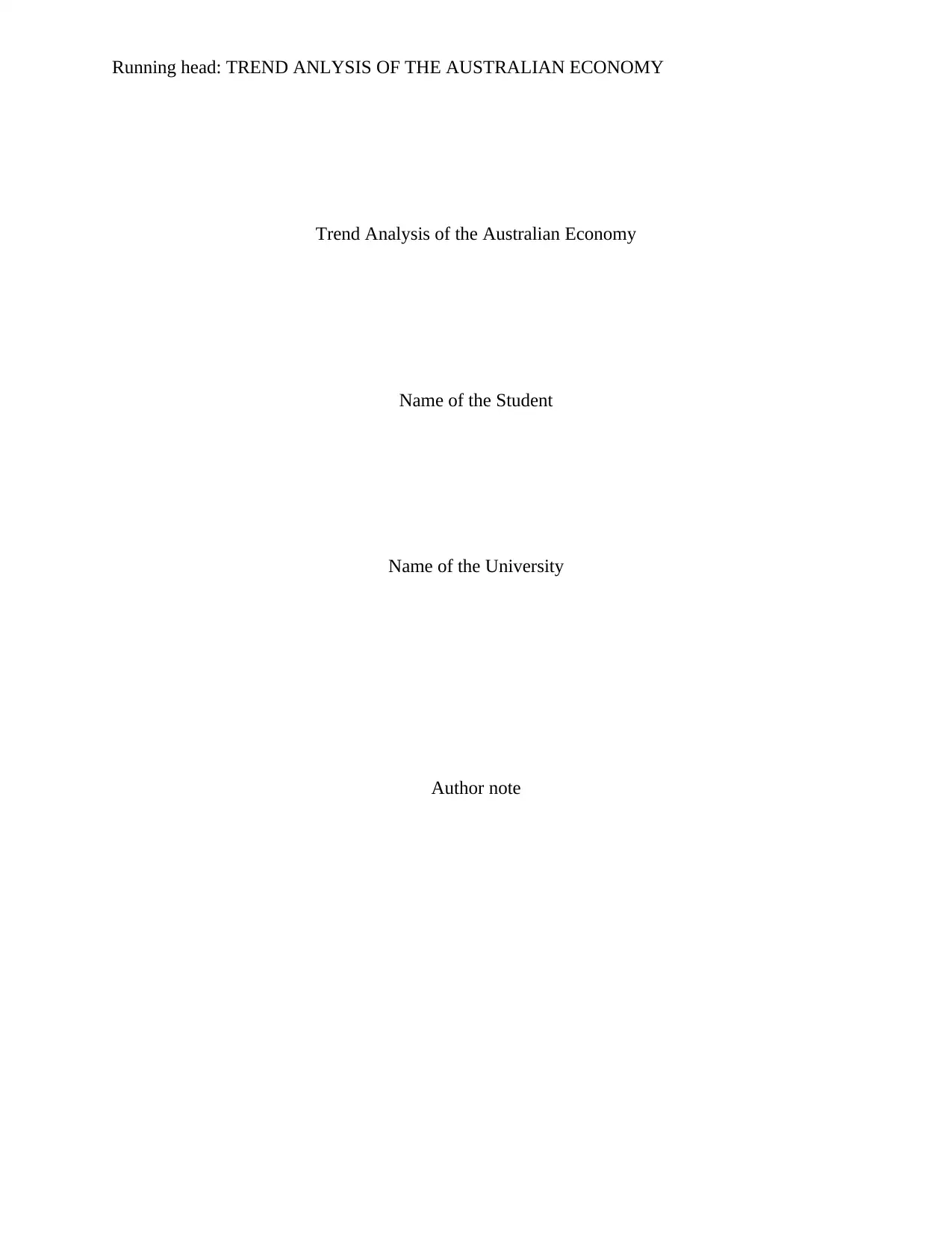
Running head: TREND ANLYSIS OF THE AUSTRALIAN ECONOMY
Trend Analysis of the Australian Economy
Name of the Student
Name of the University
Author note
Trend Analysis of the Australian Economy
Name of the Student
Name of the University
Author note
Paraphrase This Document
Need a fresh take? Get an instant paraphrase of this document with our AI Paraphraser
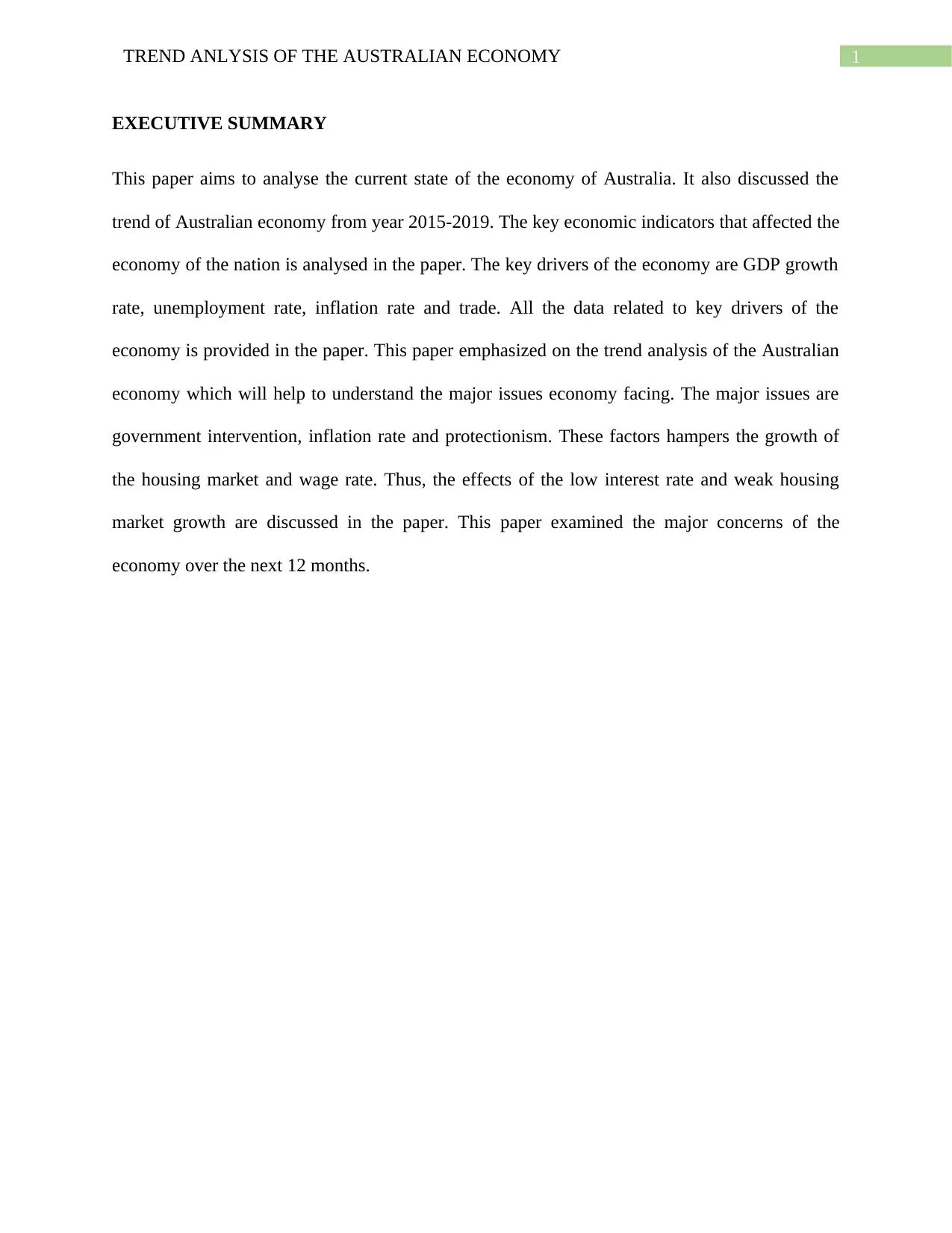
1TREND ANLYSIS OF THE AUSTRALIAN ECONOMY
EXECUTIVE SUMMARY
This paper aims to analyse the current state of the economy of Australia. It also discussed the
trend of Australian economy from year 2015-2019. The key economic indicators that affected the
economy of the nation is analysed in the paper. The key drivers of the economy are GDP growth
rate, unemployment rate, inflation rate and trade. All the data related to key drivers of the
economy is provided in the paper. This paper emphasized on the trend analysis of the Australian
economy which will help to understand the major issues economy facing. The major issues are
government intervention, inflation rate and protectionism. These factors hampers the growth of
the housing market and wage rate. Thus, the effects of the low interest rate and weak housing
market growth are discussed in the paper. This paper examined the major concerns of the
economy over the next 12 months.
EXECUTIVE SUMMARY
This paper aims to analyse the current state of the economy of Australia. It also discussed the
trend of Australian economy from year 2015-2019. The key economic indicators that affected the
economy of the nation is analysed in the paper. The key drivers of the economy are GDP growth
rate, unemployment rate, inflation rate and trade. All the data related to key drivers of the
economy is provided in the paper. This paper emphasized on the trend analysis of the Australian
economy which will help to understand the major issues economy facing. The major issues are
government intervention, inflation rate and protectionism. These factors hampers the growth of
the housing market and wage rate. Thus, the effects of the low interest rate and weak housing
market growth are discussed in the paper. This paper examined the major concerns of the
economy over the next 12 months.
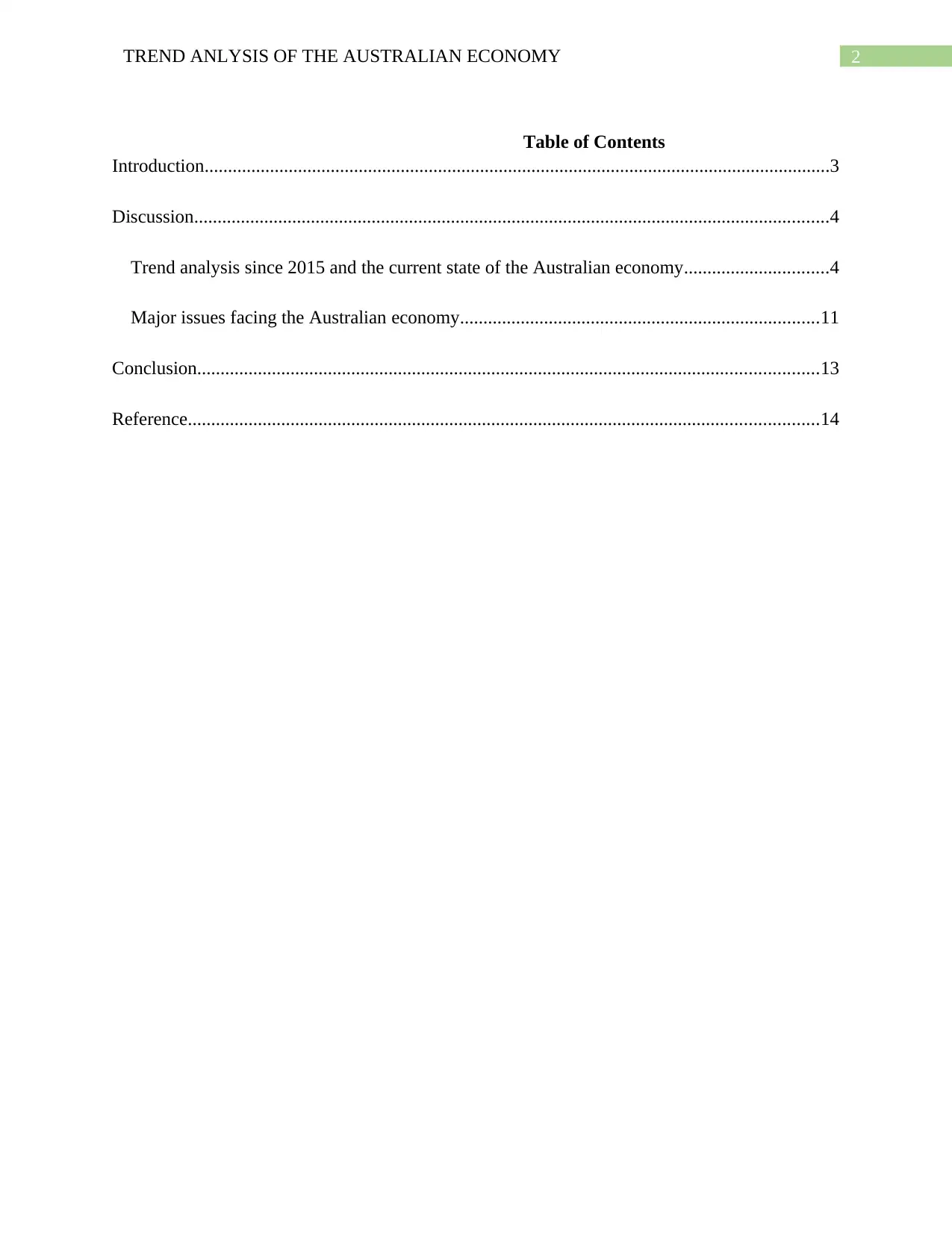
2TREND ANLYSIS OF THE AUSTRALIAN ECONOMY
Table of Contents
Introduction......................................................................................................................................3
Discussion........................................................................................................................................4
Trend analysis since 2015 and the current state of the Australian economy...............................4
Major issues facing the Australian economy.............................................................................11
Conclusion.....................................................................................................................................13
Reference.......................................................................................................................................14
Table of Contents
Introduction......................................................................................................................................3
Discussion........................................................................................................................................4
Trend analysis since 2015 and the current state of the Australian economy...............................4
Major issues facing the Australian economy.............................................................................11
Conclusion.....................................................................................................................................13
Reference.......................................................................................................................................14
⊘ This is a preview!⊘
Do you want full access?
Subscribe today to unlock all pages.

Trusted by 1+ million students worldwide
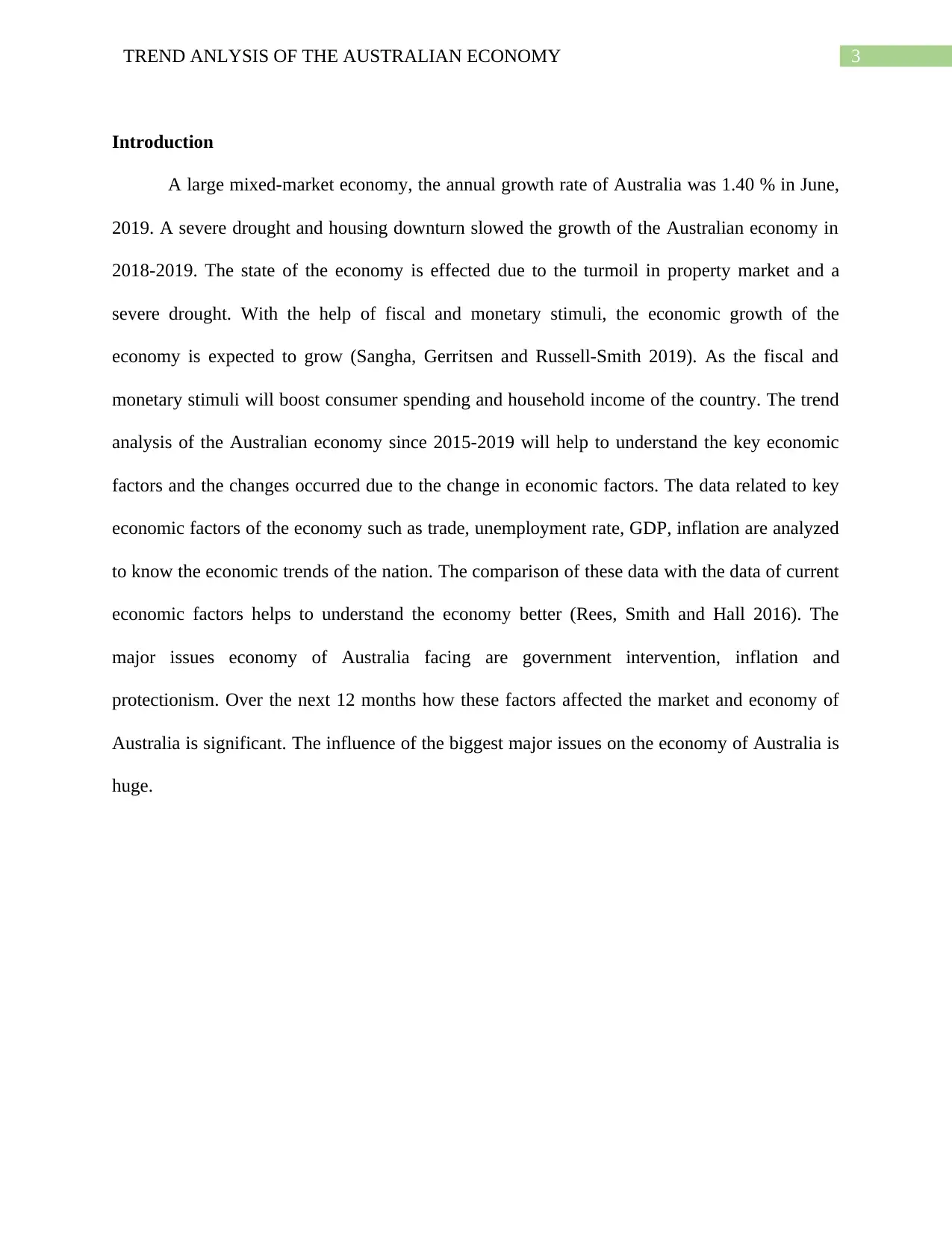
3TREND ANLYSIS OF THE AUSTRALIAN ECONOMY
Introduction
A large mixed-market economy, the annual growth rate of Australia was 1.40 % in June,
2019. A severe drought and housing downturn slowed the growth of the Australian economy in
2018-2019. The state of the economy is effected due to the turmoil in property market and a
severe drought. With the help of fiscal and monetary stimuli, the economic growth of the
economy is expected to grow (Sangha, Gerritsen and Russell-Smith 2019). As the fiscal and
monetary stimuli will boost consumer spending and household income of the country. The trend
analysis of the Australian economy since 2015-2019 will help to understand the key economic
factors and the changes occurred due to the change in economic factors. The data related to key
economic factors of the economy such as trade, unemployment rate, GDP, inflation are analyzed
to know the economic trends of the nation. The comparison of these data with the data of current
economic factors helps to understand the economy better (Rees, Smith and Hall 2016). The
major issues economy of Australia facing are government intervention, inflation and
protectionism. Over the next 12 months how these factors affected the market and economy of
Australia is significant. The influence of the biggest major issues on the economy of Australia is
huge.
Introduction
A large mixed-market economy, the annual growth rate of Australia was 1.40 % in June,
2019. A severe drought and housing downturn slowed the growth of the Australian economy in
2018-2019. The state of the economy is effected due to the turmoil in property market and a
severe drought. With the help of fiscal and monetary stimuli, the economic growth of the
economy is expected to grow (Sangha, Gerritsen and Russell-Smith 2019). As the fiscal and
monetary stimuli will boost consumer spending and household income of the country. The trend
analysis of the Australian economy since 2015-2019 will help to understand the key economic
factors and the changes occurred due to the change in economic factors. The data related to key
economic factors of the economy such as trade, unemployment rate, GDP, inflation are analyzed
to know the economic trends of the nation. The comparison of these data with the data of current
economic factors helps to understand the economy better (Rees, Smith and Hall 2016). The
major issues economy of Australia facing are government intervention, inflation and
protectionism. Over the next 12 months how these factors affected the market and economy of
Australia is significant. The influence of the biggest major issues on the economy of Australia is
huge.
Paraphrase This Document
Need a fresh take? Get an instant paraphrase of this document with our AI Paraphraser
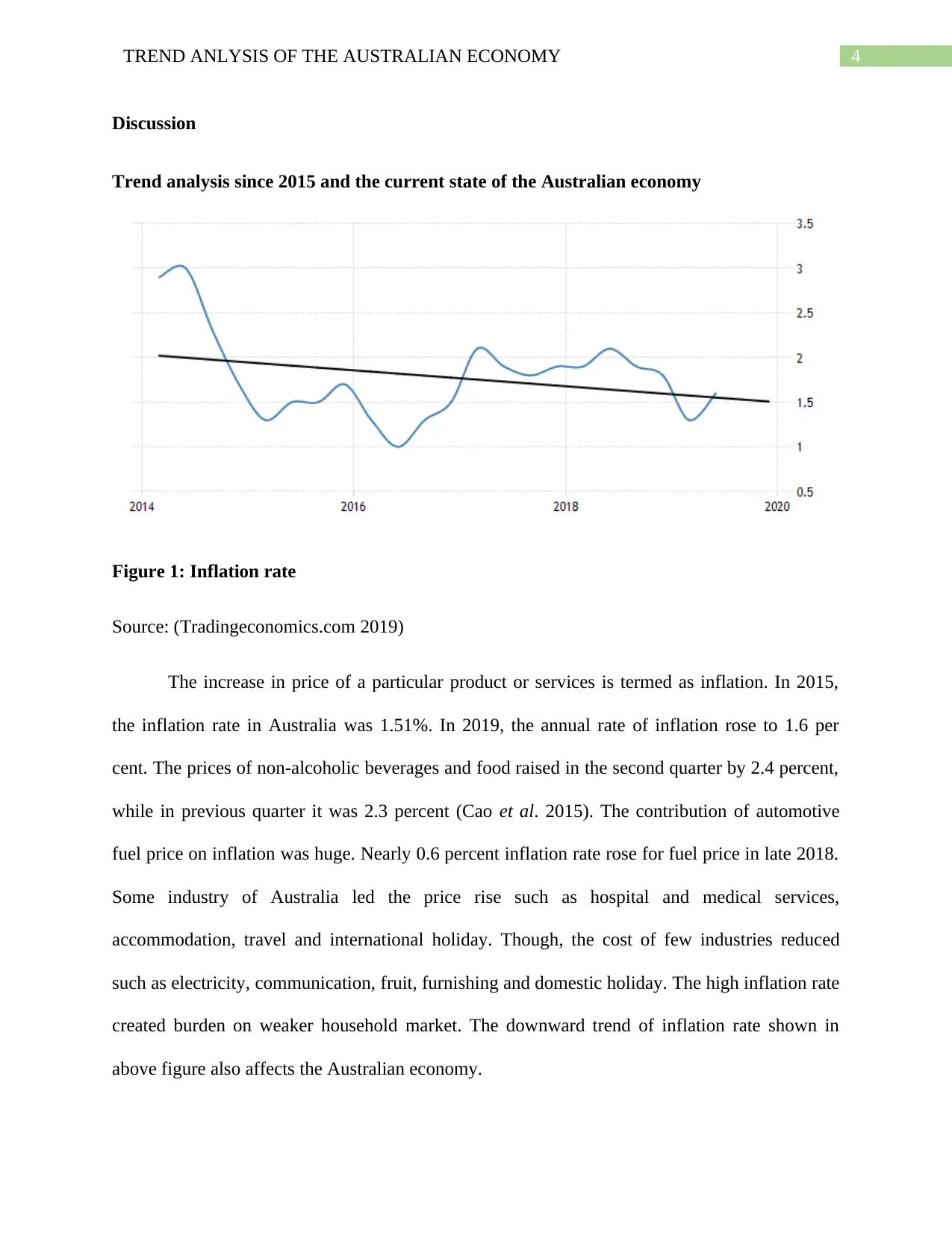
4TREND ANLYSIS OF THE AUSTRALIAN ECONOMY
Discussion
Trend analysis since 2015 and the current state of the Australian economy
Figure 1: Inflation rate
Source: (Tradingeconomics.com 2019)
The increase in price of a particular product or services is termed as inflation. In 2015,
the inflation rate in Australia was 1.51%. In 2019, the annual rate of inflation rose to 1.6 per
cent. The prices of non-alcoholic beverages and food raised in the second quarter by 2.4 percent,
while in previous quarter it was 2.3 percent (Cao et al. 2015). The contribution of automotive
fuel price on inflation was huge. Nearly 0.6 percent inflation rate rose for fuel price in late 2018.
Some industry of Australia led the price rise such as hospital and medical services,
accommodation, travel and international holiday. Though, the cost of few industries reduced
such as electricity, communication, fruit, furnishing and domestic holiday. The high inflation rate
created burden on weaker household market. The downward trend of inflation rate shown in
above figure also affects the Australian economy.
Discussion
Trend analysis since 2015 and the current state of the Australian economy
Figure 1: Inflation rate
Source: (Tradingeconomics.com 2019)
The increase in price of a particular product or services is termed as inflation. In 2015,
the inflation rate in Australia was 1.51%. In 2019, the annual rate of inflation rose to 1.6 per
cent. The prices of non-alcoholic beverages and food raised in the second quarter by 2.4 percent,
while in previous quarter it was 2.3 percent (Cao et al. 2015). The contribution of automotive
fuel price on inflation was huge. Nearly 0.6 percent inflation rate rose for fuel price in late 2018.
Some industry of Australia led the price rise such as hospital and medical services,
accommodation, travel and international holiday. Though, the cost of few industries reduced
such as electricity, communication, fruit, furnishing and domestic holiday. The high inflation rate
created burden on weaker household market. The downward trend of inflation rate shown in
above figure also affects the Australian economy.
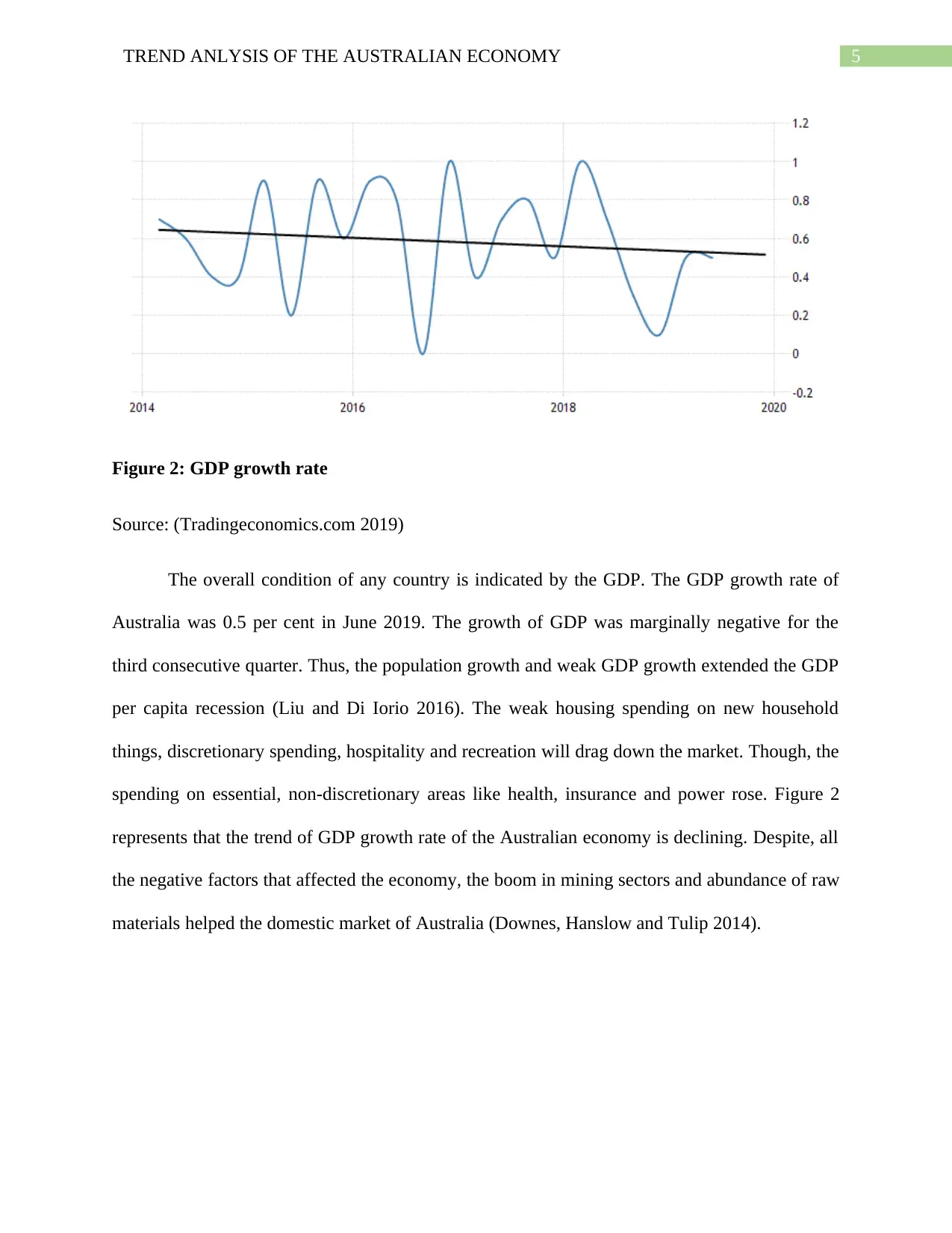
5TREND ANLYSIS OF THE AUSTRALIAN ECONOMY
Figure 2: GDP growth rate
Source: (Tradingeconomics.com 2019)
The overall condition of any country is indicated by the GDP. The GDP growth rate of
Australia was 0.5 per cent in June 2019. The growth of GDP was marginally negative for the
third consecutive quarter. Thus, the population growth and weak GDP growth extended the GDP
per capita recession (Liu and Di Iorio 2016). The weak housing spending on new household
things, discretionary spending, hospitality and recreation will drag down the market. Though, the
spending on essential, non-discretionary areas like health, insurance and power rose. Figure 2
represents that the trend of GDP growth rate of the Australian economy is declining. Despite, all
the negative factors that affected the economy, the boom in mining sectors and abundance of raw
materials helped the domestic market of Australia (Downes, Hanslow and Tulip 2014).
Figure 2: GDP growth rate
Source: (Tradingeconomics.com 2019)
The overall condition of any country is indicated by the GDP. The GDP growth rate of
Australia was 0.5 per cent in June 2019. The growth of GDP was marginally negative for the
third consecutive quarter. Thus, the population growth and weak GDP growth extended the GDP
per capita recession (Liu and Di Iorio 2016). The weak housing spending on new household
things, discretionary spending, hospitality and recreation will drag down the market. Though, the
spending on essential, non-discretionary areas like health, insurance and power rose. Figure 2
represents that the trend of GDP growth rate of the Australian economy is declining. Despite, all
the negative factors that affected the economy, the boom in mining sectors and abundance of raw
materials helped the domestic market of Australia (Downes, Hanslow and Tulip 2014).
⊘ This is a preview!⊘
Do you want full access?
Subscribe today to unlock all pages.

Trusted by 1+ million students worldwide
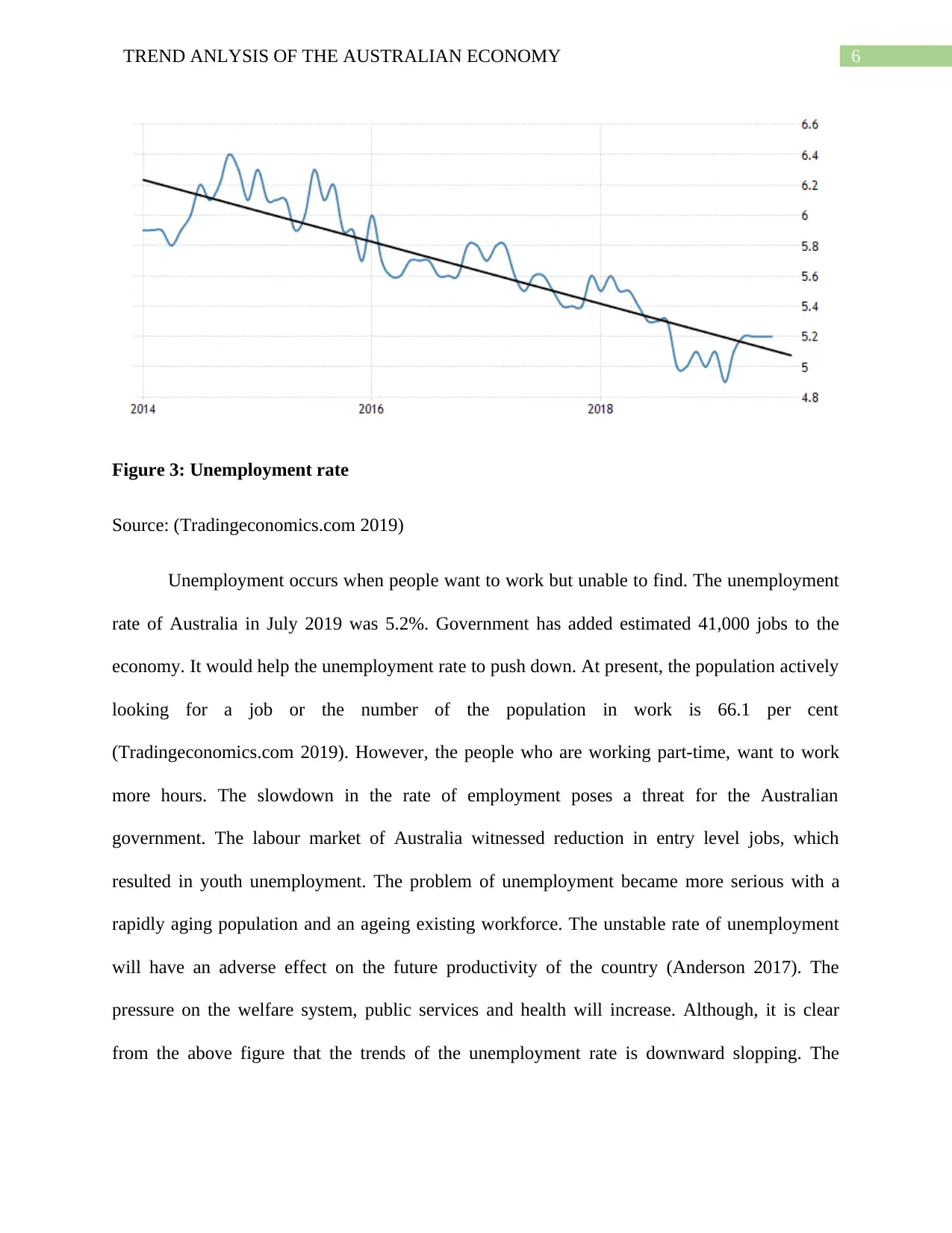
6TREND ANLYSIS OF THE AUSTRALIAN ECONOMY
Figure 3: Unemployment rate
Source: (Tradingeconomics.com 2019)
Unemployment occurs when people want to work but unable to find. The unemployment
rate of Australia in July 2019 was 5.2%. Government has added estimated 41,000 jobs to the
economy. It would help the unemployment rate to push down. At present, the population actively
looking for a job or the number of the population in work is 66.1 per cent
(Tradingeconomics.com 2019). However, the people who are working part-time, want to work
more hours. The slowdown in the rate of employment poses a threat for the Australian
government. The labour market of Australia witnessed reduction in entry level jobs, which
resulted in youth unemployment. The problem of unemployment became more serious with a
rapidly aging population and an ageing existing workforce. The unstable rate of unemployment
will have an adverse effect on the future productivity of the country (Anderson 2017). The
pressure on the welfare system, public services and health will increase. Although, it is clear
from the above figure that the trends of the unemployment rate is downward slopping. The
Figure 3: Unemployment rate
Source: (Tradingeconomics.com 2019)
Unemployment occurs when people want to work but unable to find. The unemployment
rate of Australia in July 2019 was 5.2%. Government has added estimated 41,000 jobs to the
economy. It would help the unemployment rate to push down. At present, the population actively
looking for a job or the number of the population in work is 66.1 per cent
(Tradingeconomics.com 2019). However, the people who are working part-time, want to work
more hours. The slowdown in the rate of employment poses a threat for the Australian
government. The labour market of Australia witnessed reduction in entry level jobs, which
resulted in youth unemployment. The problem of unemployment became more serious with a
rapidly aging population and an ageing existing workforce. The unstable rate of unemployment
will have an adverse effect on the future productivity of the country (Anderson 2017). The
pressure on the welfare system, public services and health will increase. Although, it is clear
from the above figure that the trends of the unemployment rate is downward slopping. The
Paraphrase This Document
Need a fresh take? Get an instant paraphrase of this document with our AI Paraphraser
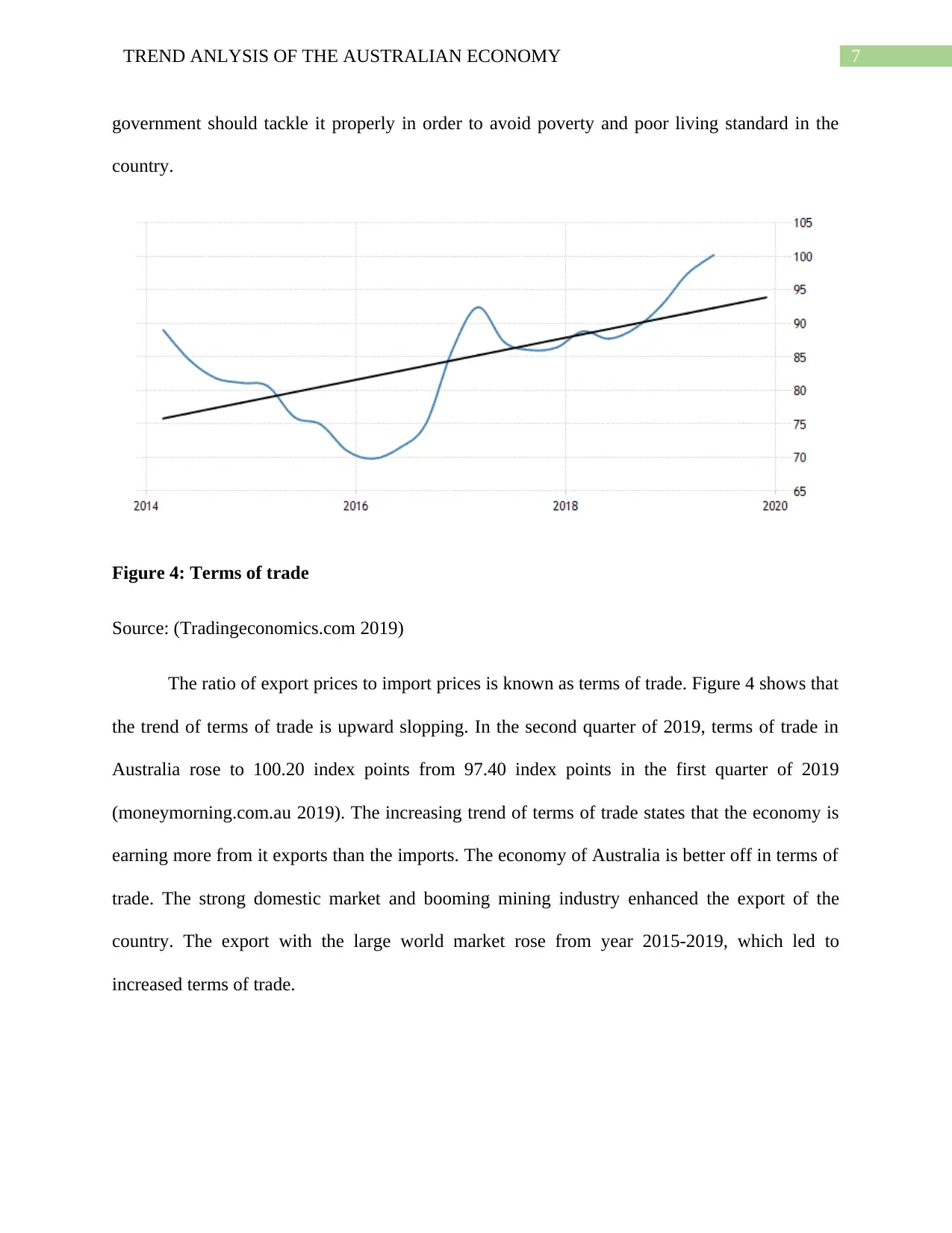
7TREND ANLYSIS OF THE AUSTRALIAN ECONOMY
government should tackle it properly in order to avoid poverty and poor living standard in the
country.
Figure 4: Terms of trade
Source: (Tradingeconomics.com 2019)
The ratio of export prices to import prices is known as terms of trade. Figure 4 shows that
the trend of terms of trade is upward slopping. In the second quarter of 2019, terms of trade in
Australia rose to 100.20 index points from 97.40 index points in the first quarter of 2019
(moneymorning.com.au 2019). The increasing trend of terms of trade states that the economy is
earning more from it exports than the imports. The economy of Australia is better off in terms of
trade. The strong domestic market and booming mining industry enhanced the export of the
country. The export with the large world market rose from year 2015-2019, which led to
increased terms of trade.
government should tackle it properly in order to avoid poverty and poor living standard in the
country.
Figure 4: Terms of trade
Source: (Tradingeconomics.com 2019)
The ratio of export prices to import prices is known as terms of trade. Figure 4 shows that
the trend of terms of trade is upward slopping. In the second quarter of 2019, terms of trade in
Australia rose to 100.20 index points from 97.40 index points in the first quarter of 2019
(moneymorning.com.au 2019). The increasing trend of terms of trade states that the economy is
earning more from it exports than the imports. The economy of Australia is better off in terms of
trade. The strong domestic market and booming mining industry enhanced the export of the
country. The export with the large world market rose from year 2015-2019, which led to
increased terms of trade.
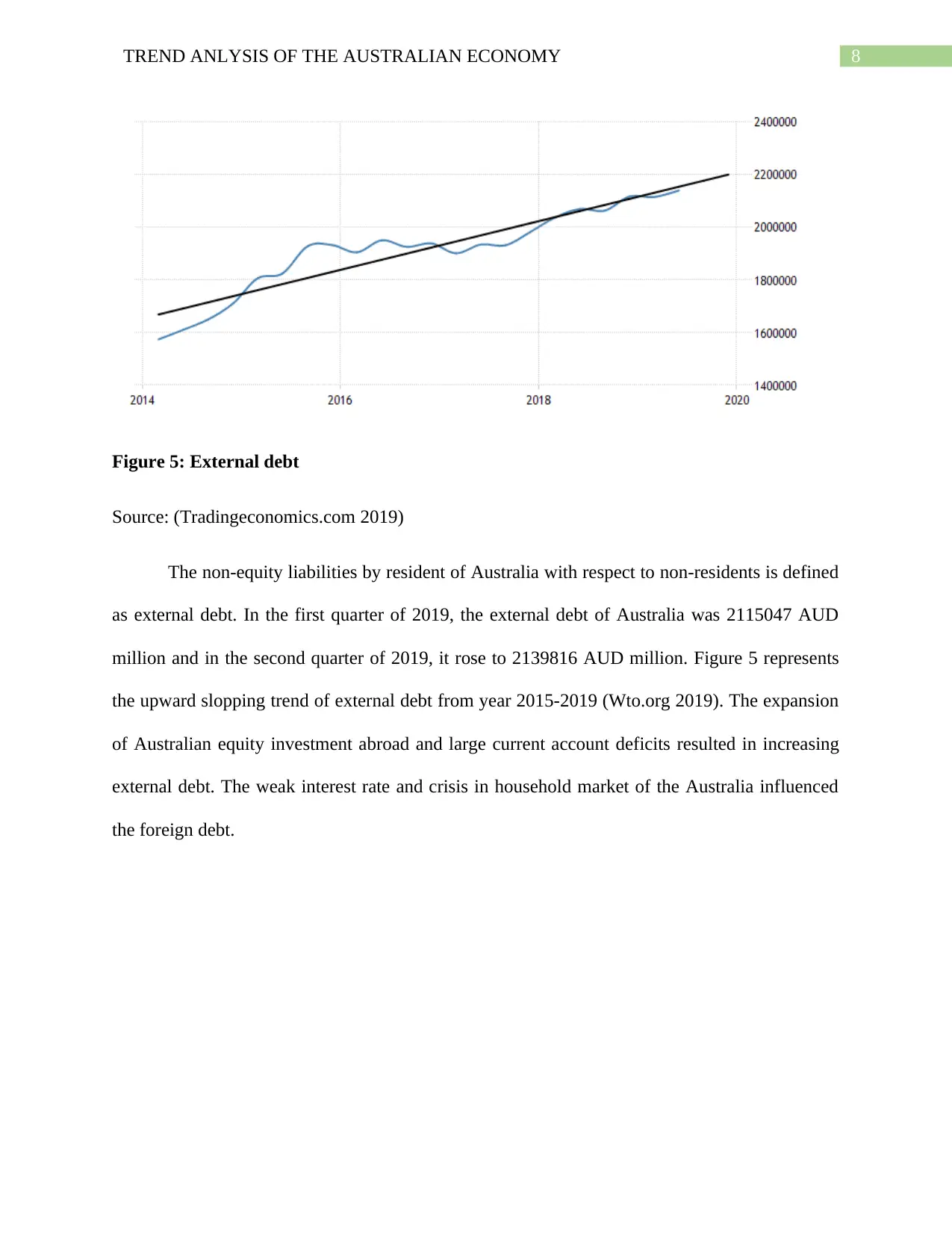
8TREND ANLYSIS OF THE AUSTRALIAN ECONOMY
Figure 5: External debt
Source: (Tradingeconomics.com 2019)
The non-equity liabilities by resident of Australia with respect to non-residents is defined
as external debt. In the first quarter of 2019, the external debt of Australia was 2115047 AUD
million and in the second quarter of 2019, it rose to 2139816 AUD million. Figure 5 represents
the upward slopping trend of external debt from year 2015-2019 (Wto.org 2019). The expansion
of Australian equity investment abroad and large current account deficits resulted in increasing
external debt. The weak interest rate and crisis in household market of the Australia influenced
the foreign debt.
Figure 5: External debt
Source: (Tradingeconomics.com 2019)
The non-equity liabilities by resident of Australia with respect to non-residents is defined
as external debt. In the first quarter of 2019, the external debt of Australia was 2115047 AUD
million and in the second quarter of 2019, it rose to 2139816 AUD million. Figure 5 represents
the upward slopping trend of external debt from year 2015-2019 (Wto.org 2019). The expansion
of Australian equity investment abroad and large current account deficits resulted in increasing
external debt. The weak interest rate and crisis in household market of the Australia influenced
the foreign debt.
⊘ This is a preview!⊘
Do you want full access?
Subscribe today to unlock all pages.

Trusted by 1+ million students worldwide
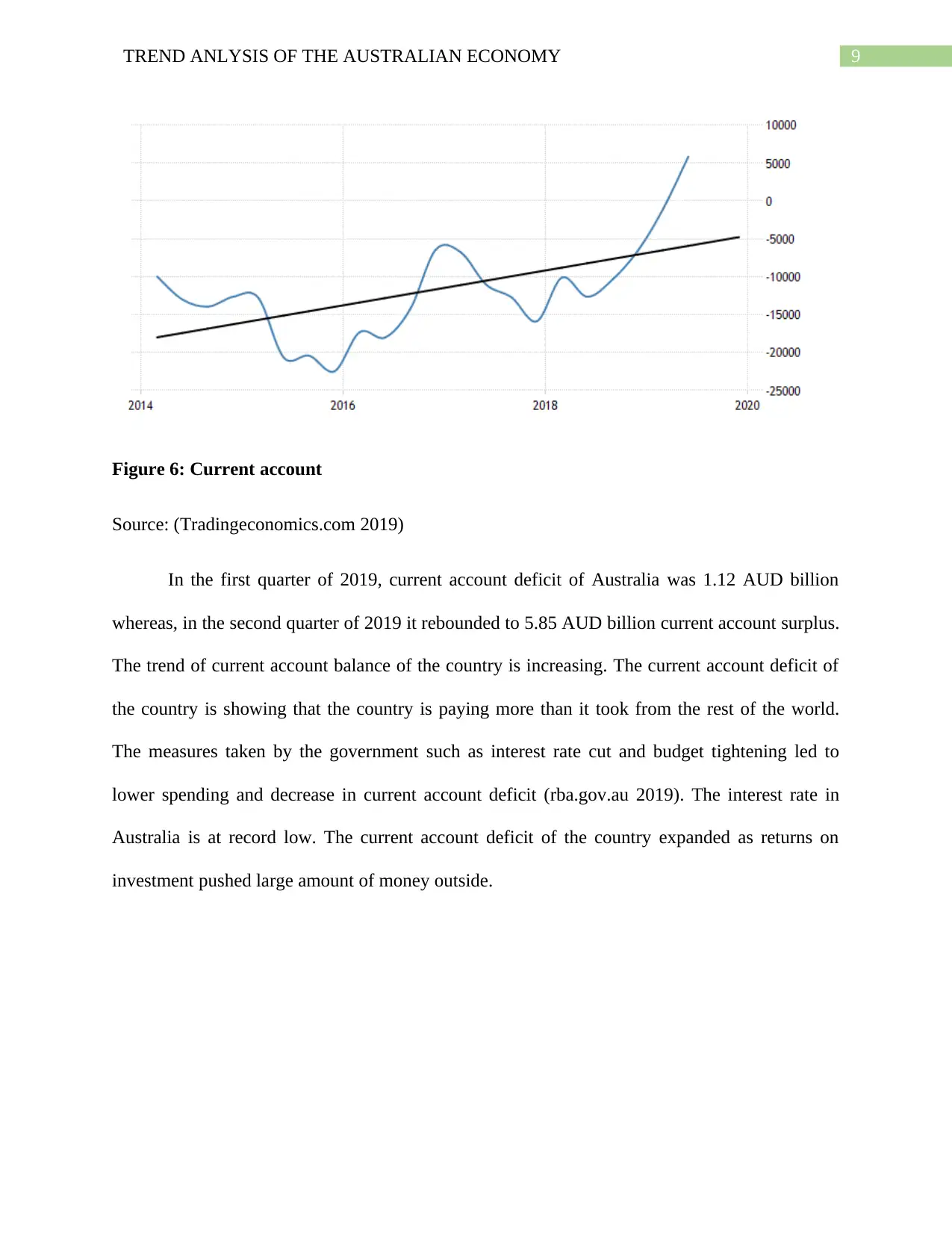
9TREND ANLYSIS OF THE AUSTRALIAN ECONOMY
Figure 6: Current account
Source: (Tradingeconomics.com 2019)
In the first quarter of 2019, current account deficit of Australia was 1.12 AUD billion
whereas, in the second quarter of 2019 it rebounded to 5.85 AUD billion current account surplus.
The trend of current account balance of the country is increasing. The current account deficit of
the country is showing that the country is paying more than it took from the rest of the world.
The measures taken by the government such as interest rate cut and budget tightening led to
lower spending and decrease in current account deficit (rba.gov.au 2019). The interest rate in
Australia is at record low. The current account deficit of the country expanded as returns on
investment pushed large amount of money outside.
Figure 6: Current account
Source: (Tradingeconomics.com 2019)
In the first quarter of 2019, current account deficit of Australia was 1.12 AUD billion
whereas, in the second quarter of 2019 it rebounded to 5.85 AUD billion current account surplus.
The trend of current account balance of the country is increasing. The current account deficit of
the country is showing that the country is paying more than it took from the rest of the world.
The measures taken by the government such as interest rate cut and budget tightening led to
lower spending and decrease in current account deficit (rba.gov.au 2019). The interest rate in
Australia is at record low. The current account deficit of the country expanded as returns on
investment pushed large amount of money outside.
Paraphrase This Document
Need a fresh take? Get an instant paraphrase of this document with our AI Paraphraser
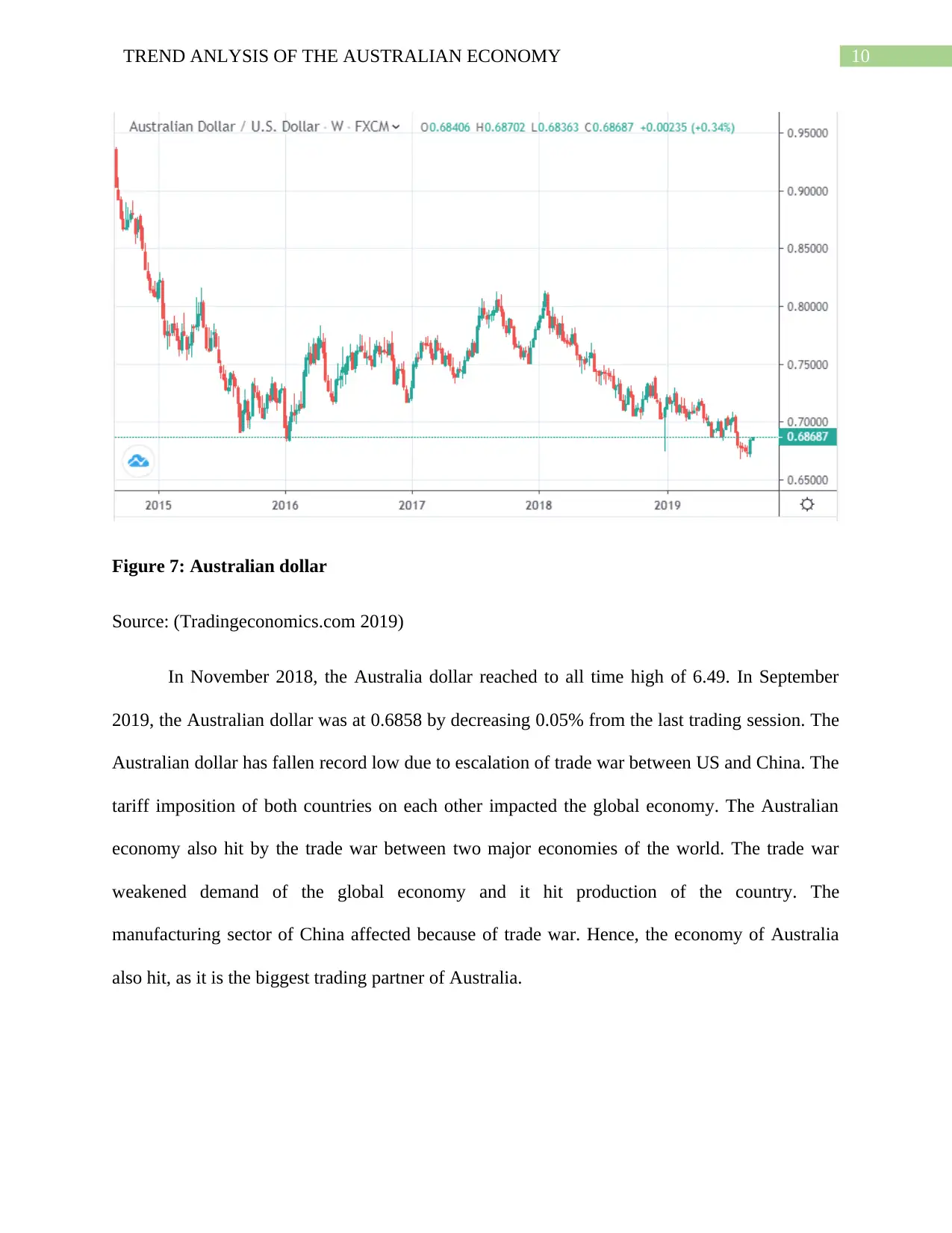
10TREND ANLYSIS OF THE AUSTRALIAN ECONOMY
Figure 7: Australian dollar
Source: (Tradingeconomics.com 2019)
In November 2018, the Australia dollar reached to all time high of 6.49. In September
2019, the Australian dollar was at 0.6858 by decreasing 0.05% from the last trading session. The
Australian dollar has fallen record low due to escalation of trade war between US and China. The
tariff imposition of both countries on each other impacted the global economy. The Australian
economy also hit by the trade war between two major economies of the world. The trade war
weakened demand of the global economy and it hit production of the country. The
manufacturing sector of China affected because of trade war. Hence, the economy of Australia
also hit, as it is the biggest trading partner of Australia.
Figure 7: Australian dollar
Source: (Tradingeconomics.com 2019)
In November 2018, the Australia dollar reached to all time high of 6.49. In September
2019, the Australian dollar was at 0.6858 by decreasing 0.05% from the last trading session. The
Australian dollar has fallen record low due to escalation of trade war between US and China. The
tariff imposition of both countries on each other impacted the global economy. The Australian
economy also hit by the trade war between two major economies of the world. The trade war
weakened demand of the global economy and it hit production of the country. The
manufacturing sector of China affected because of trade war. Hence, the economy of Australia
also hit, as it is the biggest trading partner of Australia.
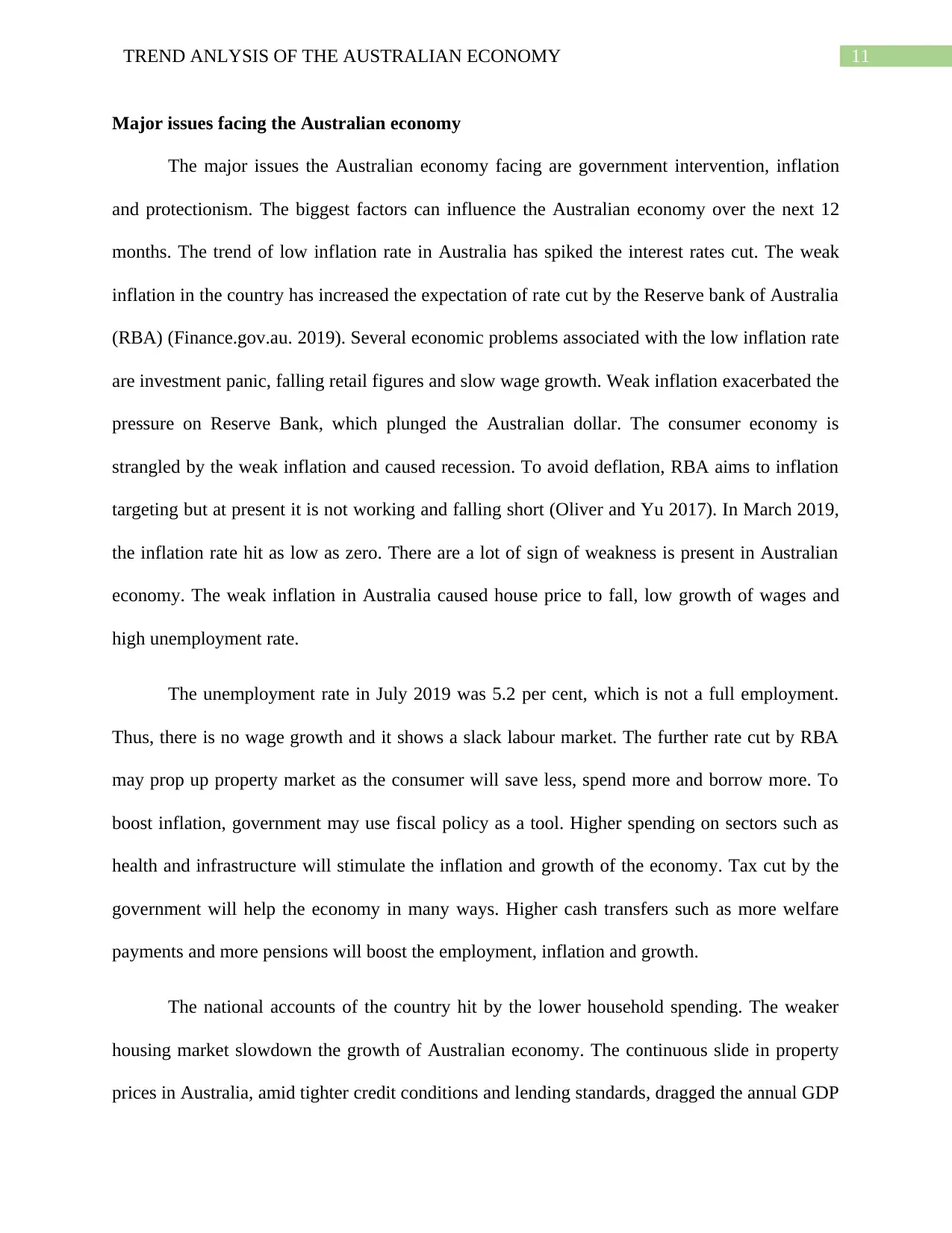
11TREND ANLYSIS OF THE AUSTRALIAN ECONOMY
Major issues facing the Australian economy
The major issues the Australian economy facing are government intervention, inflation
and protectionism. The biggest factors can influence the Australian economy over the next 12
months. The trend of low inflation rate in Australia has spiked the interest rates cut. The weak
inflation in the country has increased the expectation of rate cut by the Reserve bank of Australia
(RBA) (Finance.gov.au. 2019). Several economic problems associated with the low inflation rate
are investment panic, falling retail figures and slow wage growth. Weak inflation exacerbated the
pressure on Reserve Bank, which plunged the Australian dollar. The consumer economy is
strangled by the weak inflation and caused recession. To avoid deflation, RBA aims to inflation
targeting but at present it is not working and falling short (Oliver and Yu 2017). In March 2019,
the inflation rate hit as low as zero. There are a lot of sign of weakness is present in Australian
economy. The weak inflation in Australia caused house price to fall, low growth of wages and
high unemployment rate.
The unemployment rate in July 2019 was 5.2 per cent, which is not a full employment.
Thus, there is no wage growth and it shows a slack labour market. The further rate cut by RBA
may prop up property market as the consumer will save less, spend more and borrow more. To
boost inflation, government may use fiscal policy as a tool. Higher spending on sectors such as
health and infrastructure will stimulate the inflation and growth of the economy. Tax cut by the
government will help the economy in many ways. Higher cash transfers such as more welfare
payments and more pensions will boost the employment, inflation and growth.
The national accounts of the country hit by the lower household spending. The weaker
housing market slowdown the growth of Australian economy. The continuous slide in property
prices in Australia, amid tighter credit conditions and lending standards, dragged the annual GDP
Major issues facing the Australian economy
The major issues the Australian economy facing are government intervention, inflation
and protectionism. The biggest factors can influence the Australian economy over the next 12
months. The trend of low inflation rate in Australia has spiked the interest rates cut. The weak
inflation in the country has increased the expectation of rate cut by the Reserve bank of Australia
(RBA) (Finance.gov.au. 2019). Several economic problems associated with the low inflation rate
are investment panic, falling retail figures and slow wage growth. Weak inflation exacerbated the
pressure on Reserve Bank, which plunged the Australian dollar. The consumer economy is
strangled by the weak inflation and caused recession. To avoid deflation, RBA aims to inflation
targeting but at present it is not working and falling short (Oliver and Yu 2017). In March 2019,
the inflation rate hit as low as zero. There are a lot of sign of weakness is present in Australian
economy. The weak inflation in Australia caused house price to fall, low growth of wages and
high unemployment rate.
The unemployment rate in July 2019 was 5.2 per cent, which is not a full employment.
Thus, there is no wage growth and it shows a slack labour market. The further rate cut by RBA
may prop up property market as the consumer will save less, spend more and borrow more. To
boost inflation, government may use fiscal policy as a tool. Higher spending on sectors such as
health and infrastructure will stimulate the inflation and growth of the economy. Tax cut by the
government will help the economy in many ways. Higher cash transfers such as more welfare
payments and more pensions will boost the employment, inflation and growth.
The national accounts of the country hit by the lower household spending. The weaker
housing market slowdown the growth of Australian economy. The continuous slide in property
prices in Australia, amid tighter credit conditions and lending standards, dragged the annual GDP
⊘ This is a preview!⊘
Do you want full access?
Subscribe today to unlock all pages.

Trusted by 1+ million students worldwide
1 out of 17
Related Documents
Your All-in-One AI-Powered Toolkit for Academic Success.
+13062052269
info@desklib.com
Available 24*7 on WhatsApp / Email
![[object Object]](/_next/static/media/star-bottom.7253800d.svg)
Unlock your academic potential
Copyright © 2020–2025 A2Z Services. All Rights Reserved. Developed and managed by ZUCOL.




